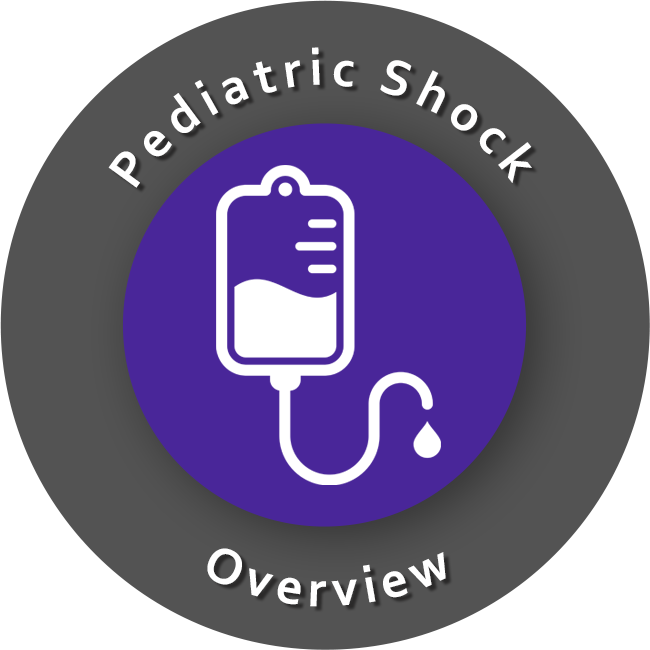
Pediatric shock is a condition that occurs when the delivery of oxygen and nutrients to the organs and tissues of the body is compromised. Shock occurs on a continuum and ranges from mild to severe.
As a result of the altered oxygen and nutrient delivery, the metabolic demands of the body are not met, and if not corrected will result in end-organ dysfunction and damage.
As organ dysfunction and damage continues, it can ultimately lead to the death of the critically-ill child.
Types of Pediatric Shock:
- Shock can be caused by a wide array of disorders, and can be divided into four major categories.
- Hypovolemic shock: Shock caused by inadequate circulating volume.
- Distributive shock: Shock caused by maldistribution of the circulating volume.
- Cardiogenic shock: Shock caused by primary pump (heart) failure.
- Obstructive shock: Shock caused by obstruction of blood flow to and from the heart.
These four categories are hypovolemic shock, distributive shock, cardiogenic shock, and obstructive shock. Use the links below to review each category of shock in detail.
These links are also listed at the end of Part 3 of this overview.
Understanding Shock:
In order to recognize and treat shock effectively, it is important to understand the underlying pathophysiology of shock.
Shock results from a failure in one or more of the components involved in the tissue oxygen delivery process.
The components involved in oxygen delivery to the tissues are:(Read the brief summary of all three components and then open the expanded explanation.)
- Sufficient cardiac output that provides enough oxygen-saturated blood to meet the demands of the tissues and organs of the body.
Explanation
- Cardiac output is defined as HEART RATE x STROKE VOLUME.
Three factors that influence stroke volume are preload, afterload, and contractility.
Preload is influenced by the volume and pressure of the blood in the left ventricle, and can be thought of as the amount of ventricular stretch at the end of diastole just before the left ventricle pumps.
Afterload is the resistance that the heart must overcome to eject the blood from the left ventricle into the systemic circulation.
Contractility is the intrinsic strength of the ventricle to contract and eject blood from the heart.
(i.e. If contractility of the heart is increased, the ventricle would more fully empty is contents upon ejection. Any one of these three factors (preload, afterload, or contractility) can be altered to change stroke volume. - There are a number of pathologies that commonly affect stroke volume by reducing blood volume which results in inadequate preload. These include severe dehydration caused by vomiting and diarrhea, hemorrhage, or vasodilation.
- There are a number of pathologies and congenital abnormalities that can effect stroke volume by causing inadequate contractility. Pathologies include myocarditis, drug or toxin overdose, and possibly hypoglycemia.
- Rarely, a decrease in stroke volume can occur as a result of an increase in afterload caused by severe pulmonary hypertension and congenital aortic abnormalities.
- Cardiac output is defined as HEART RATE x STROKE VOLUME.
- Adequate hemoglobin concentration with sufficiently oxygen-saturated hemoglobin.
Explanation
- If the hemoglobin concentration of the blood is low, less oxygen will be delivered to the tissues and organs. In this case, even if the oxygen saturation is 100% there still would be a low amount of oxygen being delivered to the tissues because the reduced hemoglobin would limit the amount of oxygen that can be delivered in a given time.
- Proper distribution of the blood to appropriate organs and tissues.
Explanation
- One of the major ways that the body regulates blood flow to the tissues and organs is by increasing or decreasing the size of the blood vessels. When the size of the blood vessel is made larger, the resistance is decreased. When the size of the blood vessel is made smaller, the resistance is increased. When there are pathologic processes at work, this can abnormally increase or decrease the size of the vessels, and it can have a negative effect on the proper distribution of blood to the organs and tissues. Adequate blood flow is the primary means by which oxygen is carried to the tissues and organs of the body. Adequate blood flow is dependent upon cardiac output and systemic vascular resistance.
Cardiac output has a direct effect upon the progression or improvement of shock.
Cardiac output = stroke volume (preload, afterload, and contractility) x heart rate.
Summary sentence: If you change heart rate, preload, afterload, or contractility, you alter cardiac output.
Go to Pediatric Shock Overview Part 2
Go to Pediatric Shock Overview Part 3
Mohammed Rezaul Karim says
Thanks for such a nice writing with an explanation.
Sonny Yates says
Jeff,
I am confused about some things. I would appreciate your help
1) Would it be fair to say that in distributive shock pulse pressure is usually wide to begin with as vasodilation causes the DBP to drop while the SBP generally stays the same at least early?
2) As the compensation factors begin to fail that wide PP then narrows as SBP falls to meet the DBP?
3) Can you tell me why one uses nor-epi instead of epi. I find confusing and sometimes contradictory information when I look that up.
Thanks Jeff,
Sonny Yates
ACLS says
Statement #1 is correct. (you probably will see a drop in systolic blood pressure, but there will still be a widening pulse pressure.)
Statement #2 is correct.
3. Norepinephrine has very selective vasoconstrictive affects while not affecting heart rate, stroke volume, and other cardiovascular aspects. When you are dealing with distributive shock in the late stages, you only want vasoconstriction. Norepinephrine provides this. Epinephrine can provide this, but it comes with beta adrenergic affects of increased heart rate and stroke volume which can lead to other problems in late stages of distributive shock.
I hope that makes sense.
Kind regards,
Jeff
Willem Nel says
Thanks for your site!
Jeff with admin. says
You are welcome!